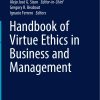Materials Experience 2 Expanding Territories of Materials and Design 1st Edition by Owain Pedgley, Valentina Rognoli, Elvin Karana ISBN 0128192445 9780128192443
$70.00 Original price was: $70.00.$50.00Current price is: $50.00.
Instant download Materials Experience 2 Expanding Territories of Materials and Design Unknown after payment
Materials Experience 2: Expanding Territories of Materials and Design 1st Edition by Owain Pedgley, Valentina Rognoli, Elvin Karana – Ebook PDF Instant Download/Delivery: 0128192445, 978-0128192443
Full dowload Materials Experience 2 Expanding Territories of Materials and Design 1st Edition after payment

Product details:
ISBN 10: 0128192445
ISBN 13: 978-0128192443
Author: Owain Pedgley, Valentina Rognoli, Elvin Karana
Materials Experience 2: Expanding Territories of Materials and Design is the follow-up companion to Materials Experience published in 2014. Materials experience as a concept has evolved substantially and is now mobilized to incorporate new ways of thinking and designing. Through all-new peer-reviewed chapters and project write-ups, the book presents critical perspectives on new and emerging relationships between designers, materials, and artifacts. Subtitled Expanding Territories of Materials and Design, the book examines in depth the increased prevalence of material-driven design practices, as well as the changing role of materials themselves, toward active and influential agents within and outside design processes. The book is essential reading for anyone involved in materials and design, containing 11 authoritative chapters and 18 illustrated accounts of contemporary research projects and practices.
- Presents both the knowledge and understanding of what ‘new and emerging materials’ are, where they come from, and how they can be used effectively in design
- Looks at how the professional responsibility of material selection is evolving into a more complex and active role of material ‘creation’ and ‘appropriation’
- Explores how an elevated sensitivity to materials influence people’s experiences of the designed world
Materials Experience 2 Expanding Territories of Materials and Design 1st Table of contents:
Chapter 1. Expanding territories of materials and design
Abstract
1.1 Introduction
1.2 Expanding territories
1.3 Where next?
Chapter 2. How new materials speak: analyzing the language of emerging materials in architecture
Abstract
2.1 Introduction
2.2 Emerging materials
2.3 The language of materials
2.4 Establishing a dialog
2.5 Common materials, uncommon applications
2.6 Uncommon materials, common applications
2.7 Uncommon materials, uncommon applications
2.8 Advancing material linguistics
Chapter 3. Experiential craft: knowing through analog and digital materials experience
Abstract
3.1 Introduction: crafting with analog and digital materials
3.2 Three concepts of materials experience: materialness, material-driven design, and material agency
3.3 Handcrafting through digital tools
3.4 Material engagement in digital fabrication
3.5 Gestural crafting in virtual reality
3.6 Translational craft: when digital meets analog materials experience
3.7 Discussion: knowing through analog and digital materials experience
Acknowledgments
References
Chapter 4. Digital crafting: a new frontier for material design
Abstract
4.1 Introduction
4.2 A brief history of digital design and fabrication
4.3 The digital continuum
4.4 Individual production
4.5 Toward a new esthetics
4.6 Digital crafting in educational practice
Acknowledgments
References
Chapter 5. Surface texture as a designed material-product attribute
Abstract
5.1 Introduction
5.2 Texture interpretations
5.3 Visual versus tactile texture
5.4 Micro- versus macro-texture
5.5 Inherent texture versus texturization
5.6 Surface texture roadmap
5.7 Functional texture
5.8 Discussion and conclusions
Acknowledgments
References
Chapter 6. Material change: transforming experience
Abstract
6.1 Introduction
6.2 The interaction of material change and material experience
6.3 Material change as a design strategy
6.4 Conclusion
Chapter 7. A renewed recognition of the materiality of design in a circular economy: the case of bio-based plastics
Abstract
7.1 Introduction
7.2 Bio-based and biodegradable plastics: a short review
7.3 Circular economy
7.4 Designing with bio-based polymers in a circular economy: opportunities and challenges
7.5 Conclusion
References
Chapter 8. Biotextiles: making textiles in a context of climate and biodiversity emergency
Abstract
8.1 Introduction
8.2 Textile material innovation in an environmental crisis context
8.3 Textile innovation in the context of the emergence of biodesign
8.4 Strategies for designing textiles with living systems
8.5 Conclusion
References
Chapter 9. Defining the DIY-Materials approach
Abstract
9.1 The DIY-Materials phenomenon
9.2 DIY-Materials: theoretical foundations
9.3 DIY-Materials cases: collection and classification
9.4 DIY-Materials classification: the five kingdoms
9.5 Interrelationships between kingdoms and their updated definition
Acknowledgments
References
Chapter 10. Design and science: a pathway for material design
Abstract
10.1 Intersections between design and science
10.2 Divergences and convergences
10.3 The evolution of the relationship between design and materials science
10.4 The new material experience generated by the intersection between design and science
10.5 Conclusion
Acknowledgments
References
Chapter 11. Materialdesign: design with designed materials
Abstract
11.1 Introduction
11.2 Design with designed materials
11.3 Sensitive properties
11.4 Informed materials
11.5 Institute for Materialdesign IMD case studies
11.6 Hybrid—material, properties, …, communication
11.7 Nomenclature_Interdependence and In-Between
11.8 Outlook
People also search for Materials Experience 2 Expanding Territories of Materials and Design 1st:
experience with materials example
materials experience
hazardous materials expert assistant
materials for the experiment 3 maplestory


